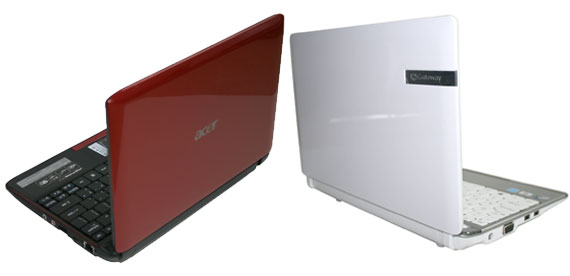Gateway and Acer Netbooks: Wonder Twin Powers, Activate!
by Vivek Gowri on April 28, 2010 2:22 AM ESTAcer and Gateway Netbooks: Typical Pine Trail
One of the biggest challenges in reviewing netbooks is differentiating between them and deciding what really separates the best in class from the also-rans. Unfortunately, with all of the performance and feature parity shared by the standard bearers, this is a really difficult task. With established hardware manufacturers like Dell, HP, Acer, ASUS, and MSI making cohesive and well-thought-out devices, the quality of design and manufacturing ends up similar, so often personal preference separates the various netbooks on paper. In practice, the only thing that differs is the quality of the screen, which is dependant on how much priority the manufacturer places on the LCD. Beyond that, there isn’t a whole lot to separate any netbook from the rest of the class.

At the end of the day, the Aspire One 532h and LT2120u are just netbooks. Solid competitors in the netbook class, but nothing mind blowing, and not really good enough to knock the ASUS Eee 1001P off its throne. They're not built quite as well and the LCD isn't near the high quality panel the ASUS uses, but the Aspire One (and Gateway clone) are still capable netbooks. I can't recommend them over the 1001P, primarily because of the LCD, but other than that the difference between them and the rest of the netbook class is pretty slight. The Acer and Gateway are both specced and priced to equal the 1001P and others, so if you prefer the Acer or Gateway brands, these are definitely up to scratch.
And of course, we would be remiss if we didn't mention where CULV machines fall in all of this. You can get a single-core CULV machine like the Acer 1410 for within $70 of the cost of these netbooks. This is true for any of the netbooks in the running—not just the Gateway and Acer, but also the Eee 1001P and everything else. Spending another $50-100 could get you a dual-core processor, but then you are paying significantly more than a netbook. If you are willing to spend a little more, you can get vastly improved performance and features, but with less battery life and a higher cost.










15 Comments
View All Comments
JarredWalton - Wednesday, April 28, 2010 - link
I've got a couple AMD-based laptop reviews in the works. Vivek will be getting the Acer Ferrari One this week (CULV alternative), and I've got M300 and M600 laptops to compare with an i3-430m setup. Honestly, other than a lower price AMD laptops are still a tough sell in my book. The better IGP still isn't that great; the Intel HD i3/i5 IGP is good enough for anything but gaming, while the HD 4200 needs low detail and 800x600 resolution to be playable in most titles. Couple that with generally lower performance and battery life and there's not a lot of benefit.CULV with a discrete GPU can give you better battery life and gaming performance if that's what you're after, though it will cost (a lot) more. At that point, the CULV + Optimus laptops end up being the best recommendation. So the choice is pretty much 8 hours battery life with 4500MHD (Intel CULV) or 4 hours battery life with HD 4200 (AMD), for around $400-$600.
jaydee - Wednesday, April 28, 2010 - link
But I think the ASUS Eee PC 1201T w/AMD mv-40 (http://www.newegg.com/Product/Product.aspx?Item=N8... could give the traditional Atom-based netbook a good run for it's money.About $60 more and you get 12" screen, 1366x768 resolution, 2GB of RAM, HDMI out, stronger CPU and much stronger integrated graphics. You lose on battery life, and doesn't come with an OS, but for people with extra WinXP licenses or wanting to put Linux on it, I think it provides a much stronger value than the above Acer/Gateway twins, don't you think?
How would it compare to Atom+Ion? It'll still be cheaper, but should even out the battery life.
hybrid2d4x4 - Wednesday, April 28, 2010 - link
Hey, I just wanted to throw out a suggestion for the firefox sqlite issue: install a RAMdrive app (I use Dataram RAMDisk - it's free and works flawlessly, even with win7 x64) and move your profile to the RAM drive. I did this on my HTPC as this is something that has been nagging me with a WD Green drive where the drive would noticeably lag when the head is unloaded and I start typing into the address bar. The time to generate "suggestions" as you type is now instantaneous! You can configure it to load the image on startup and save it on shutdown, so it works exactly like normal, but the only time it accesses the HDD is on startup/shutdown. It also saves you the wear of the very frequent unnecessary random writes to the HDD every time you load a page or reads when it fills in what you type.Having said that, I would also like to see how SSDs would fare in laptops, and in addition to your suggestions, I hope that Anand would also throw a typical 2.5" HDD into the SSD power charts as a reference for those of us considering SSD swaps into laptops.
m4nm4n - Wednesday, April 28, 2010 - link
If I had these connected to my Wifi router, the router would be named Gleek.popej - Thursday, June 24, 2010 - link
You wrote: "we don't know if the ASUS laptops are truly more energy efficient".You probably use ASUS Super Hybrid Engine in auto mode. When running on battery SHE cripple notebook performance. CPU and RAM frequency is reduced by 20% and battery life is longer.
I think it is a flaw in your test, that you don't check performance when on battery.